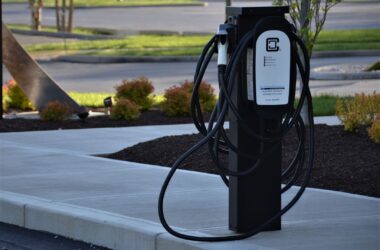Introduction
Welcome to the electrifying world of automotive innovation, where electric cars are steadily driving us toward a more sustainable future. Gone are the days when electric vehicles (EVs) were considered mere novelties or a fringe alternative to traditional gas-powered cars. Today, they are at the forefront of an automotive revolution, capturing the imaginations and investments of individuals and industries alike.
The significance of electric cars in today’s automotive landscape cannot be overstated. They’re more than just a “green alternative”—they are a testament to human ingenuity and our commitment to sustainable transportation. With zero tailpipe emissions and a rapidly growing charging infrastructure, electric cars are fast becoming a viable option for reducing our carbon footprint and mitigating the devastating effects of climate change.
So, why is there so much buzz about electric cars and the technology behind them? That’s precisely what we aim to explore in this blog post. From the intricacies of battery technology to smart features like autopilot and regenerative braking, we’ll dive deep into the technologies that are making electric cars not only feasible but increasingly efficient and convenient. Whether you’re a tech enthusiast, an eco-conscious commuter, or someone curious about the future of transportation, this post will shed light on the automotive technology that’s setting the stage for a more sustainable future.
By leveraging cutting-edge automotive technology, we are on the brink of not just an evolution but a revolution that promises to redefine the way we think about personal transportation. So buckle up and get ready to journey into the world of electric cars and the groundbreaking technology that powers them.
1: The Rise of Electric Cars
The Dawn of Electric Vehicles
Believe it or not, the concept of electric cars isn’t a newfangled invention of the 21st century. The roots of electric vehicles (EVs) go back to the 19th century when inventors were tinkering with battery-powered carriages. However, due to limitations in battery technology and the rise of internal combustion engines, electric cars took a backseat for much of the 20th century.
Fast forward to the late 20th and early 21st centuries, and electric cars have experienced a resurgence like never before. Influential companies like Tesla have brought electric vehicles into the mainstream, offering not only an eco-friendly alternative but also a high-performance machine that rivals, if not outclasses, traditional cars in many aspects.
The Imperative of Zero Emissions
While electric cars have been intriguing for tech aficionados and early adopters, their true significance lies in their potential to combat climate change. Vehicles are one of the major sources of greenhouse gas emissions, contributing substantially to global warming and environmental degradation. Enter zero-emissions electric cars, which offer the promise of sustainable transportation without the damaging exhaust fumes associated with petrol or diesel engines.
Switching to electric vehicles could dramatically reduce the amount of CO2 being emitted into the atmosphere, not only helping to combat climate change but also leading to cleaner air in our cities. As renewable energy sources like solar and wind power become more prevalent, the environmental benefits of electric cars will only multiply.
The Public and Private Sector Join Forces
The rise of electric cars has been made possible through a blend of public enthusiasm, governmental support, and private-sector innovation. Numerous governments around the world are offering incentives for electric vehicle purchases and are investing in the development of charging infrastructure. Meanwhile, automotive companies are committed to releasing a greater variety of electric models that cater to different needs, from compact cars and family SUVs to luxury sedans and high-performance sports cars.
In conclusion, the rise of electric cars represents a monumental shift in both public perception and automotive technology. They are more than just vehicles; they are a vital tool in our global effort to reduce greenhouse gas emissions and combat climate change. As we move further into the 21st century, electric cars are undoubtedly setting the pace for a more sustainable, eco-friendly future in automotive transportation.
2: How Do Electric Cars Work?
One of the most common questions people have when considering a switch to electric vehicles is, “How do electric cars work?” At first glance, electric cars might seem like complex, high-tech machines—and they are—but their core functioning is elegantly simple. Understanding how electric cars work begins with recognizing that they’re essentially battery-powered vehicles, a far cry from their internal combustion engine (ICE) counterparts that rely on burning fuel.
Electric Motors: The Heart of the Machine
The most crucial component that distinguishes an electric car from a gasoline-powered one is the electric motor. Traditional cars use internal combustion engines that burn fossil fuels to create a series of small explosions, powering the pistons and ultimately the wheels. Electric cars, on the other hand, use electric motors that run on electricity stored in batteries.
An electric motor is remarkably efficient, compact, and provides instant torque. That means you get immediate power the moment you step on the accelerator, a feature that has caught the attention of sports car enthusiasts and everyday drivers alike. Moreover, electric motors have fewer moving parts than traditional engines, reducing wear and tear and minimizing maintenance requirements.
The Role of the Battery
Powering the electric motor is a high-capacity battery pack, usually made from lithium-ion cells. When you plug your electric car into a charging station, electricity flows into the battery pack, storing energy that the electric motor will later use to turn the wheels. This is the same basic principle as a rechargeable battery in a mobile phone or laptop, only on a much larger scale.
The Efficiency Advantage
One of the most compelling aspects of electric cars is their efficiency. In internal combustion engines, a significant amount of energy is lost through heat, noise, and other inefficiencies. Electric motors, however, can convert most of the stored electrical energy into kinetic energy, making them highly efficient and cost-effective in the long run.
In summary, electric cars operate on a straightforward principle: a battery provides electricity to an electric motor, which then powers the wheels. The absence of a complex internal combustion engine results in fewer moving parts, lower maintenance, and a much more energy-efficient vehicle. As we will see in the following sections, the simple genius of this design is complemented by a range of other technologies that make electric cars an increasingly viable and sustainable transportation option.
3: The Heart of Electric Cars – Battery Technology
Different Types of Batteries in Electric Vehicles
If electric motors are the muscles of an electric car, the battery serves as its heart, pumping energy into the system. But not all batteries are created equal. The types of batteries used in electric vehicles have evolved over the years, and today, there are several kinds to choose from:
- Lead-Acid Batteries: These are the oldest type of rechargeable batteries and are generally cheaper but less efficient. They are mostly used in early electric vehicle models and are now being phased out.
- Nickel-Metal Hydride (NiMH) Batteries: These offer higher energy density than lead-acid batteries but still fall short of what’s currently considered the gold standard—lithium-ion.
- Lithium-Ion Batteries: Most modern electric cars use lithium-ion batteries due to their high energy density, lightweight characteristics, and longevity. They also charge faster and degrade slower than their predecessors.
- Solid-State Batteries: These are the next frontier in electric vehicle battery technology. They promise even higher energy densities, quicker charging times, and safer operation compared to liquid electrolyte-based lithium-ion batteries.
Advancements in Battery Technology
The landscape of electric vehicle battery technology is continually evolving, with researchers and engineers tirelessly working to bring about the next big breakthrough. One of the most anticipated advancements in this space is the development of solid-state batteries.
Solid-State Batteries: Unlike conventional lithium-ion batteries that use a liquid electrolyte to conduct ions between the anode and cathode, solid-state batteries use a solid electrolyte. This simple change has far-reaching implications:
- Higher Energy Density: Solid-state batteries can hold more energy, potentially doubling the range of electric vehicles.
- Faster Charging: Because they don’t heat up as much during the charging process, solid-state batteries can be charged more quickly.
- Improved Safety: The absence of flammable liquid electrolytes makes them less prone to catching fire.
These innovations don’t just promise incremental improvements; they herald a seismic shift in what electric cars can do. Once commercialized, solid-state batteries could address some of the most significant challenges facing electric vehicles today, such as range anxiety and lengthy charging times.
In closing, battery technology is at the core of making electric cars a viable and sustainable option for the future of transportation. As advancements like solid-state batteries move from the laboratory to the production line, we can expect electric cars to become even more efficient, pushing us closer to a world where sustainable transportation is not just an option but the norm.
4: Eliminating Range Anxiety
What is Range Anxiety?
The term “range anxiety” refers to the fear that an electric vehicle will run out of charge before reaching its destination or a charging station. This concern is one of the most significant barriers potential EV owners face when considering making the switch from a traditional internal combustion engine vehicle. While gasoline stations are ubiquitous and refueling is quick, the same has not been true for electric charging stations—especially fast-charging ones. The result is a psychological hurdle that makes people apprehensive about embracing electric cars, even as the technology improves.
Why Range Anxiety is a Significant Concern
For electric vehicles to become the default choice for sustainable transportation, eliminating or significantly reducing range anxiety is crucial. The worry about running out of battery can overshadow the numerous advantages of electric cars, such as reduced emissions, lower operating costs, and technological innovations. This concern is more than just a minor inconvenience; it’s a substantial roadblock in the journey toward mass adoption of electric vehicles.
Solutions in the Pipeline
Addressing range anxiety is not a one-size-fits-all endeavor; it requires a multi-faceted approach:
- Better Battery Technology: As discussed in the previous section, advancements in battery technology like solid-state batteries can significantly extend the range of electric cars, making range anxiety less of an issue.
- Fast-Charging Infrastructure: Increasing the number and availability of fast-charging stations can make recharging an electric car as convenient as refilling a gas tank. Companies like Tesla, with their Supercharger network, are already making strides in this direction.
- Smart Range Estimation: Modern electric cars come equipped with intelligent systems that can accurately estimate the remaining range based on driving behavior, traffic conditions, and even weather, helping drivers make informed decisions about when and where to charge.
- Onboard Range-Extending Technologies: Some electric vehicles are now equipped with solar panels or small internal combustion engines that act as generators, providing additional power to extend the vehicle’s range.
- Public Awareness and Education: Dispelling myths and providing accurate information can go a long way in alleviating range anxiety. Test drives, informational campaigns, and real-world testimonials can help prospective buyers understand that for most daily uses, an electric car’s range is more than sufficient.
In summary, range anxiety is a legitimate concern but one that is being actively addressed through technological innovation and public awareness efforts. As batteries improve, fast-charging stations become more widespread, and onboard technology gets smarter, the shadow of range anxiety is likely to diminish, paving the way for broader adoption of electric vehicles.
5: Charging Infrastructure
The Various Types of Charging Stations
An electric car is only as good as the charging infrastructure supporting it. So, what types of charging stations are available, and how do they work?
- Level 1 Charging: Also known as the standard home charging, Level 1 uses a regular household 120-volt AC outlet. It’s the slowest form of charging, often requiring overnight charging to fill a depleted battery.
- Level 2 Charging: These chargers use a 240-volt AC outlet and are commonly found in homes with dedicated EV charging stations, as well as public and workplace locations. They can typically charge an electric vehicle in 4–8 hours.
- DC Fast Charging: These are the fastest charging stations available for electric cars, often found along highways and in commercial areas. They use direct current (DC) and can charge most batteries up to 80% in around 20–30 minutes.
- Tesla Superchargers: Exclusive to Tesla vehicles, these are among the fastest charging stations, capable of charging a Tesla car up to 80% in about 15–20 minutes.
The Importance of a Robust Charging Network
Having a diverse and accessible range of charging options is crucial for alleviating range anxiety and encouraging the widespread adoption of electric cars. A robust charging infrastructure offers several benefits:
- Convenience: More charging stations mean more convenience for electric vehicle owners, reducing the time and effort required to find a charging point.
- Increased Range: A dense network of fast-charging stations along highways and in cities expands the effective range of electric vehicles, making longer trips more feasible.
- Flexibility: With various charging options available, electric vehicle owners can choose the most convenient and cost-effective method to meet their needs, whether they are commuting to work or going on a road trip.
- Encourages Adoption: A reliable and convenient charging infrastructure can significantly influence potential buyers to consider electric vehicles as a viable alternative to fossil fuel-powered cars.
In conclusion, a well-developed charging infrastructure is indispensable for the growth and acceptance of electric cars. As fast-charging technologies continue to evolve and become more widespread, the future looks bright for electric vehicles and sustainable transportation.
6: Regenerative Braking and Efficiency
Understanding Regenerative Braking
One of the most innovative features of electric cars that often goes unnoticed is regenerative braking. Unlike traditional braking systems that convert kinetic energy into heat, thus wasting it, regenerative braking systems capture this energy and use it to recharge the car’s battery. In other words, every time you slow down or go downhill, your electric car’s battery gets a little boost, extending its range and improving efficiency.
How Regenerative Braking Improves Efficiency
The question of “How is regenerative braking efficient?” can be answered in a few key points:
- Energy Recovery: Traditional brakes dissipate kinetic energy as heat. In contrast, regenerative brakes capture this energy, converting it back into electricity that charges the battery.
- Extended Range: By recharging the battery during braking, regenerative braking can extend the vehicle’s range, reducing the frequency of charging stops and thus enhancing the overall efficiency.
- Reduced Wear and Tear: Because regenerative braking assists in slowing down the vehicle, the mechanical brakes don’t have to work as hard, resulting in reduced wear and tear and lower maintenance costs.
Other Technologies that Improve Efficiency
Regenerative braking is not the only technology aimed at improving the efficiency of electric vehicles. Here are some other notable features:
- Aerodynamic Design: Many electric cars are designed with aerodynamic efficiency in mind, which reduces drag and improves mileage.
- Low Rolling Resistance Tires: These specialized tires minimize wasted energy, further contributing to a vehicle’s overall efficiency.
- Lightweight Materials: The use of lightweight composite materials can significantly reduce a vehicle’s weight, thereby requiring less energy to move.
- Variable Regeneration: Some electric vehicles allow drivers to adjust the level of regenerative braking, optimizing it for different driving conditions.
- Efficient HVAC Systems: Electric vehicles are incorporating increasingly efficient heating, ventilation, and air conditioning systems that consume less power, preserving the battery for driving.
In conclusion, regenerative braking is a groundbreaking technology that significantly enhances the efficiency of electric cars. When combined with other efficiency-boosting technologies like aerodynamic design and low rolling resistance tires, electric vehicles are becoming more practical and cost-effective for everyday use.
7: Autopilot and Smart Features
Smart Features in Electric Cars
Beyond energy efficiency and environmental benefits, electric cars are at the forefront of technology and innovation. They often come equipped with a wide range of smart features designed to enhance safety, convenience, and the overall driving experience. Some of these features include:
- Adaptive Cruise Control: This system adjusts your speed to maintain a safe distance from the vehicle ahead, providing some level of automation while cruising on highways.
- Lane Keeping Assist: Cameras and sensors keep track of road markings to ensure the car stays within its lane, gently steering it back if it begins to drift.
- Collision Avoidance: Advanced algorithms detect potential collisions and either alert the driver or take action to avoid or mitigate the impact.
- Smart Charging: Electric vehicles can be programmed to charge during off-peak hours, helping owners take advantage of lower electricity rates.
The Role of Autopilot
Autopilot takes these smart features to the next level, offering semi-autonomous driving capabilities that can handle tasks like steering, accelerating, and braking within certain conditions. Tesla’s Autopilot and Full Self-Driving packages are perhaps the most famous, but other manufacturers like Nissan, BMW, and Audi are also developing their versions of semi-autonomous driving systems.
While these features are designed to assist the driver rather than replace them, they do make steps towards full automation and contribute to a safer and more relaxed driving experience.
The Future of Autonomous Electric Vehicles
As technology continues to advance, the line between electric vehicles and autonomous vehicles is becoming increasingly blurred. Several companies are in the race to produce fully autonomous electric cars, which would bring about a transformation in how we perceive mobility. These vehicles promise to:
- Enhance Safety: Autonomous systems can potentially reduce human error, one of the leading causes of road accidents.
- Improve Traffic Flow: With superior data analysis and reaction times, autonomous vehicles could optimize speed and routes, reducing congestion.
- Democratize Transportation: Self-driving electric cars could provide a more accessible form of mobility for those who are unable to drive due to age or disability.
- Environmental Impact: Coupled with clean electric technology, autonomous vehicles could be programmed to operate at maximum efficiency, further reducing their environmental footprint.
In summary, the incorporation of smart features and autopilot functionalities in electric cars is not just a technological marvel but a glimpse into a future where our cars are safer, more efficient, and more attuned to our needs. As we look ahead, the prospect of autonomous electric vehicles looms large, promising to revolutionize our experience of mobility while minimizing our environmental impact.
8: The Vehicle-to-Grid Connection
What is Vehicle-to-Grid Technology?
Vehicle-to-Grid (V2G) technology is an exciting and innovative concept that enables electric vehicles to interact with the electrical grid. In a V2G system, not only can electric vehicles draw power from the grid for charging, but they can also send power back into the grid when needed. This bi-directional energy transfer has the potential to create a more stable, efficient, and sustainable electrical network.
How Vehicle-to-Grid Benefits Electric Car Owners
- Additional Revenue Stream: Electric car owners can potentially earn money by providing excess energy back to the grid during peak demand times, making electric vehicle ownership more financially attractive.
- Optimized Charging: V2G systems can be programmed to charge your vehicle during off-peak hours when electricity is cheaper, and sell back to the grid when rates are high, optimizing the cost of owning and operating an electric vehicle.
- Emergency Power Source: In case of a power outage, a fully charged electric vehicle could serve as a temporary power source for your home.
Advantages for the Electricity Grid
- Grid Stability: Having a network of electric vehicles supplying energy can help balance demand and supply, thus stabilizing the grid, especially during peak load times.
- Renewable Energy Integration: V2G technology can make it easier to incorporate renewable energy sources like solar and wind into the grid by providing a buffer to handle the variability of these sources.
- Energy Storage: Electric vehicles could act as mobile energy storage units, allowing utilities to draw upon this stored energy when needed, reducing the need for building large, expensive, stationary storage facilities.
- Demand Response: Utilities can better manage the electrical load during peak and off-peak times by communicating with connected electric vehicles to modulate charging or discharging as needed.
In conclusion, vehicle-to-grid technology presents a unique and mutually beneficial relationship between electric cars and the electricity grid. For electric vehicle owners, V2G offers the opportunity for cost savings and even revenue generation. For the grid, it offers a dynamic solution for maintaining stability and incorporating more renewable energy sources.
As we continue to transition to a more sustainable future, technologies like vehicle-to-grid will undoubtedly play an increasingly crucial role. This brings us to the end of our comprehensive exploration into electric cars and their driving technologies. Keep an eye out for more articles that delve into the future of sustainable transportation.
9: Overcoming Challenges for Widespread Adoption
Current Challenges in Electric Vehicle Adoption
As exciting and promising as electric vehicles (EVs) are, there are still some roadblocks to their widespread adoption:
- High Costs: The initial cost of electric vehicles, especially those offering greater range and better features, can be prohibitive for the average consumer.
- Limited Range: Although EV range is steadily improving, “range anxiety” continues to be a significant barrier for potential buyers.
- Charging Infrastructure: While growing, the availability of fast-charging stations is still not at par with traditional fuel stations, particularly in rural areas.
Collaborative Efforts for Overcoming Challenges
- Government Incentives for Electric Vehicles: Various federal and state programs offer tax credits, rebates, and other incentives to reduce the overall purchase price of an electric vehicle. Initiatives like the federal Electric Vehicle Tax Credit can make EVs more affordable for the average consumer.
- Public-Private Partnerships: Governments are collaborating with the private sector to expand the charging infrastructure, speeding up the rate at which high-speed charging stations are being installed.
- Investment in R&D: Both the auto industry and governments worldwide are investing heavily in research and development to improve battery technology, aiming to increase the range and reduce the costs of electric cars.
- Education and Awareness: Public campaigns to educate people on the benefits of electric vehicles—both environmental and financial—are essential in convincing more people to make the switch.
- Fleet Adoption: Many local governments and businesses are opting to replace their fleets with electric vehicles, serving as a real-world demonstration of the viability and advantages of EV technology.
In conclusion, while there are challenges in the path toward the widespread adoption of electric vehicles, concerted efforts from both industry and government are helping to overcome these. Incentives are making EVs more financially accessible, R&D is rapidly advancing the technology, and public awareness campaigns are helping to shift perceptions.
As we wrap up this comprehensive guide to electric cars and the tech driving them, it’s clear that while obstacles remain, the road ahead is promising. The concerted efforts of industry stakeholders and governing bodies are steering us toward a more sustainable and efficient transportation future.
Conclusion: The Road Ahead for Electric Cars and Their Technologies
As we reach the end of this deep dive into the world of electric cars and the technologies propelling them, let’s take a moment to recap the key points covered:
- The Rise of Electric Cars: Electric vehicles have evolved significantly over the years and are now a viable and sustainable alternative to traditional combustion engine cars. They are increasingly seen as a key component in combating climate change.
- Mechanics of Electric Cars: The basic mechanisms that power electric vehicles, primarily electric motors, are significantly different from internal combustion engines, offering several advantages including efficiency and sustainability.
- Battery Technology: Advances in battery technology, particularly the development of solid-state batteries, have drastically improved range and reduced costs.
- Range Anxiety: While the term “range anxiety” is familiar to potential EV buyers, the industry is making strides in eliminating this concern through improved battery technology and more efficient systems.
- Charging Infrastructure: A robust network of fast-charging stations is essential for the widespread adoption of electric vehicles, and both private and public sectors are investing in this infrastructure.
- Regenerative Braking: Technologies like regenerative braking not only improve the efficiency of electric vehicles but also extend their range.
- Smart Features and Autopilot: Advanced features including adaptive cruise control, lane-keeping assist, and semi-autonomous driving capabilities are making electric cars smarter and safer.
- Vehicle-to-Grid Technology: This innovative concept allows electric vehicles to serve as potential energy storage systems, offering benefits to both consumers and the energy grid.
- Overcoming Challenges: Though challenges like high costs and limited range remain, the collaboration between the government and private sectors aims to overcome these obstacles.
Future Outlook
The future of automotive technology in electric cars is incredibly bright. We’re seeing continuous advancements that promise to make electric vehicles more efficient, accessible, and convenient. These advancements are not isolated but are part of a broader shift towards renewable energy in transportation, indicating a seismic change in how we think about mobility.
We can anticipate more innovative technologies emerging in the coming years, from full vehicle autonomy to more sustainable manufacturing processes. These technologies will further reduce the environmental impact of transportation and bring us closer to a zero-emissions future.
Thank you for joining us on this journey through the electrifying landscape of electric vehicles. The road to a sustainable transportation future is paved with innovation and collaboration, and electric cars are leading the way. Stay tuned for more insightful discussions on the technologies shaping our world.
Safe travels on your road to the future!









